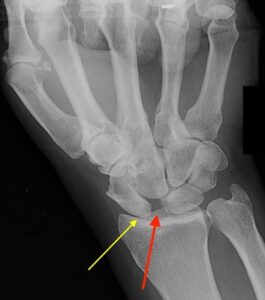This month Dr Kwan Yeoh discusses the management of Complete Scapholunate Ligament Rupture.
Please feel free to send your questions to education@orthosports.com.au

Patients often think that the initial injury is just a wrist “sprain” which improves with time – which it does! The pain subsides but perhaps never completely resolves or perhaps worsens again over months to years. This is then when we find the scenario that is being asked about here, where the patient’s ongoing pain is attributable to the chronic scapholunate ligament rupture.
The management of this largely comes down to patient symptoms and the presence or absence of secondary degenerative changes.
If the patient has pain, then an assessment must be made whether there is any secondary degenerative change in the wrist due to the carpal instability. This may involve a combination of clinical examination, X-ray, CT scan and MRI scan.
If there is no degenerative change, then a ligament reconstruction can be offered to the patient. There are several varieties of this, but they generally aim to reproduce the function of the scapholunate ligament with a grafted tendon or other structure. These are supplemented with K-wires and cast immobilisation, and require months of rehabilitation to optimise the outcome. Even then, it would be unusual to achieve normal range of motion or pre-injury function, and there is still a chance of longer term degenerative wrist arthritis.

If there is already degenerative change or irreducible carpal misalignment at time of presentation, then there is no point in ligament reconstruction. The wrist has started down the path of scapholunate advanced collapse (SLAC wrist). A ligament reconstruction will not change this trajectory but will commit the patient to a long period of recovery and hard work for very little change in ultimate outcome. We therefore accept the inevitable post-traumatic SLAC wrist, and the aim of treatment is to minimise pain and maximise function for as long as possible. This means various non-operative measures such as activity modification, use of medications or injections, targeted immobilisation and physiotherapy, and education of the long-term expectations.
When the pain is no longer adequately controlled by non-operative means, the operation of choice scenario is one of various “salvage” operations. Salvage procedures generally involve resection of certain carpal bones and either limited or complete fusion of the wrist, or a wrist arthroplasty. Limited procedures generally give some pain relief but further degeneration will occur and will eventually require more surgery. This could be further limited procedures, but they all head towards the common end point of a complete wrist arthrodesis or arthroplasty.
In the end, it is much better to diagnose scapholunate ligament ruptures early and prevent them from becoming a chronic problem. Any patient who has an acute hyperextension injury to the wrist should be examined closely for tenderness over the scapholunate ligament and any signs of carpal instability. If there is any suspicion of this, then an x-ray and an MRI should be performed.

